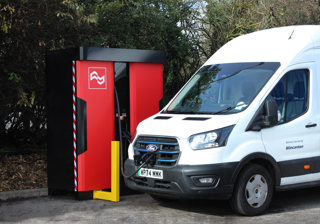The workplace car park is set for rapid and radical transformation as companies electrify their fleets. The requirement to top up or completely recharge electric vehicle batteries during the working day and overnight means organisations will need to install multiple charge points.
This represents virgin territory for most fleet operators and raises important questions about the number of chargers required, the optimum speed of chargers and their ideal location. It also demands new corporate policies about who can plug their vehicles into company chargers, when they can use charge points, and how they pay for power.
Fraser Crichton, corporate fleet operations manager at Dundee City Council (pictured above), is responsible for a network of 458 chargers and rising, some exclusively for council use and others open to the public, with the city debuting its zero-emission transition a decade ago. His start point for new charge point locations is to identify the available energy where vehicles are parked, both car parks and depots.
The distribution network operator (DNO), owner and operator of the power lines and infrastructure that connect properties to the national grid, can supply this information, which is critical for determining both the number and speed of chargers that a destination can support. Upgrades to the grid are eye-wateringly expensive, so it makes financial sense to operate within the local capacity wherever possible.
It is easier and cheaper to install a greater number of slower chargers, typically 7kW, capable of recharging a car in six to eight hours, than fewer, high-speed 50kW chargers, said Crichton.
“As a rule of thumb, when you have more than eight EVs at a site I would normally look to have a rapid 50kW charger,” he said. “The number of times people say they have put a vehicle on charge and return to find it wasn’t on charge and that the battery is flat is an issue, particularly if you have car pools with different people driving the same car. The rapid charger is your back up to boost the batteries to 50% charge in 15 minutes.”
In terms of determining the number of chargers required, Crichton advises a detailed analysis of vehicle mileages. With the new generation of EVs boasting significant ranges on a single battery charge, there’s unlikely to be a requirement for a ratio of one charger per vehicle. An EV with a 200-mile range and a daily route of 40 miles would in theory only need recharging once per week, so one charger could potentially serve five vehicles.
With the number and location of chargers decided, there’s still the question of where precisely to site them, explained Nigel Morris, business development manager, Specific, Swansea University and triple winner at the 2020 Fleet News Awards, including Best Environmental Fleet.
“The most annoying and biggest cost of putting in chargers is the grounds cost. You have to start doing surveys and if you are in leased premises you have to talk to the landowner about digging a trench,” he said. “Look at where your electricity capacity is in relationship to your switchboard; can you avoid digging and instead use a suitable wall to surface mount your chargers, which is a lot cheaper?”
If there’s no alternative to digging, added Morris, think about future expansion and make sure that you bury sufficient ducting to accommodate cables for more chargers in future. Bear in mind, too, the ergonomics of charging bays – avoid cables acting as trip hazards while drivers load their vehicles, and bays too narrow for disabled people to negotiate while plugging in their cars.
It’s also worth planning in detail how to fund a workplace recharging infrastructure, with purchase and lease options both possible, as well as deciding whether to maintain them in-house or via an outsourced maintenance contract. The selection of chargers and service support matters both for unit reliability and for the confidence and security that the supplier will still be able to source spares and offer support 10 years from now.
Beyond the £20,000-plus cost of a 50kW rapid charger, green champions might also want to budget for creating a ‘fanfare’ around EV charging bays, painting the Tarmac and adding information signs to reassure drivers about charge point infrastructure and to use for wider social media opportunities to promote corporate social responsibility commitments.
Finally, before anyone plugs in their EV at work it’s important to establish a recharging policy that establishes both user etiquette and payment.
“Employees must understand this isn’t a parking bay but a charging space. It’s really frustrating to see an EV parked but not charging, or a PHEV that only needs to be plugged in for an hour occupying a charging bay all day,” said Morris.
How to allocate the costs of charging, both in terms of systems and policy, to internal departments and private EV drivers also needs careful consideration: make it too cheap and drivers lose the incentive to charge their EVs overnight at home, which is typically the optimum charging solution; make it too expensive and it can undermine the fledgling zero emission policy. Reserving access to workplace chargers for fleet vehicles, via RFID cards, key fobs or even sunken bollards, makes sense as the wider workforce starts to adopt EVs and wants to recharge private cars at work.
Planning ahead
Future-proofing investment in workplace electric vehicle recharging infrastructure requires bold decisions, given the new technology emerging and the rapidly growing demand for power.
The capacity of the grid is limited, so fleets will require smart charging solutions that staggers the time when vehicles are actually drawing power, even if they are all plugged in simultaneously. Recharging batteries at off-peak, low tariff times can save two-thirds of EV ‘fuel’ costs, with further revenue raising opportunities in the pipeline from vehicle-to-grid technology that sees EVs store excess power and resupply either their local buildings or the national grid at peak times. Be aware, however, that for this to become a commercial reality fleets may have to commit to having their vehicles plugged in at certain times of day, which may not be operationally possible.
Finally, with net zero carbon emissions providing the impetus behind EVs, companies may also want to synchronise the installation of charge points with investment in solar roof panels, harvesting their own clean energy to power their own clean vehicles.
“If you are going to have to pay for a grid connection upgrade you might want to do a cost benefit analysis of investing in some on-site renewables plus battery storage,” said Nigel Morris, business development manager, Specific, Swansea University. “The cost of your upfront investment in panels and a battery might be less than upgrading the substation.”





















Norman Harding - 03/03/2021 12:55
The issues raised in the article are valid but only half the story. Having had my own private network of 47 charge points for several years there are other costs and responsibilities to consider. After installation there will be ongoing service and repair costs. The owner of the network will be required to carry out an annual independent safety inspection to the charging network (and to the charging cables carried in fleet vehicles). Furthemore, there is the cost of obsolescence - many of my charge points no longer work because the supplier cannot fix them or long delays waiting replacement parts - I have one defected on 27/10/2020 still not fixed because the supplier cannot get parts but this charging post was only installed less than 2 years ago.